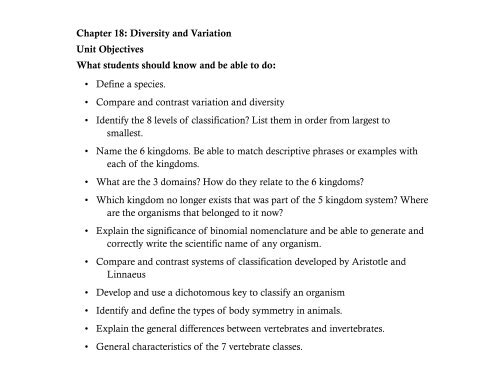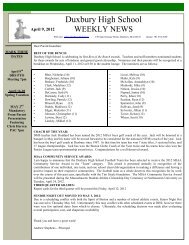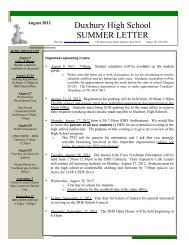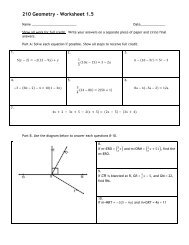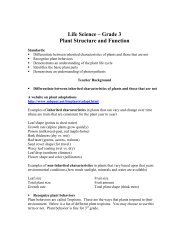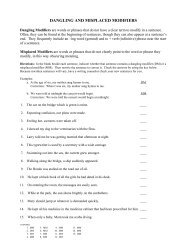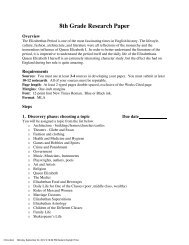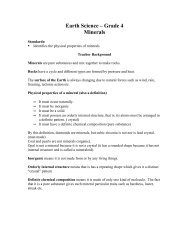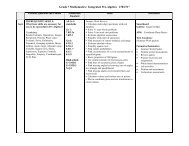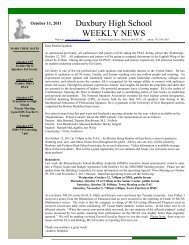Taxonomy Notes.pdf
Taxonomy Notes.pdf
Taxonomy Notes.pdf
Create successful ePaper yourself
Turn your PDF publications into a flip-book with our unique Google optimized e-Paper software.
Chapter 18: Diversity and Variation<br />
Unit Objectives<br />
What students should know and be able to do:<br />
• Define a species.<br />
• Compare and contrast variation and diversity<br />
• Identify the 8 levels of classification? List them in order from largest to<br />
smallest.<br />
• Name the 6 kingdoms. Be able to match descriptive phrases or examples with<br />
each of the kingdoms.<br />
• What are the 3 domains? How do they relate to the 6 kingdoms?<br />
• Which kingdom no longer exists that was part of the 5 kingdom system? Where<br />
are the organisms that belonged to it now?<br />
• Explain the significance of binomial nomenclature and be able to generate and<br />
correctly write the scientific name of any organism.<br />
• Compare and contrast systems of classification developed by Aristotle and<br />
Linnaeus<br />
• Develop and use a dichotomous key to classify an organism<br />
• Identify and define the types of body symmetry in animals.<br />
• Explain the general differences between vertebrates and invertebrates.<br />
• General characteristics of the 7 vertebrate classes.
5. Evolution and Biodiversity<br />
Central Concepts: Evolution is the result of genetic changes that occur in<br />
constantly changing environments. Over many generations, changes in the<br />
genetic make-up of populations may affect biodiversity through speciation and<br />
extinction.<br />
5.1 Explain how evolution is demonstrated by evidence from the fossil<br />
record, comparative anatomy, genetics, molecular biology, and examples of<br />
natural selection.<br />
5.2 Describe species as reproductively distinct groups of organisms.<br />
Recognize that species are further classified into a hierarchical taxonomic<br />
system (kingdom, phylum, class, order, family, genus, species) based on<br />
morphological, behavioral, and molecular similarities. Describe the role that<br />
geographic isolation can play in speciation.<br />
5.3 Explain how evolution through natural selection can result in changes in<br />
biodiversity through the increase or decrease of genetic diversity within a<br />
population.
Ch. 18 TAXONOMY<br />
3 Domain System<br />
5 Kingdom System
TAXONOMY- Science of classifying living things.<br />
Why classify?<br />
How Many Species? A Study Says 8.7 Million, but It’s Tricky<br />
http://www.nytimes.com/2011/08/30/science/30species.html
1st Classification System<br />
Aristotle 384-322 BC<br />
Two Groups:<br />
Grouped by size<br />
Plants Animals<br />
Grouped by habitat<br />
herbs shrubs trees air land water
Carolus Linnaeus 1707-1778<br />
All organisms should be classified using<br />
the same criteria.<br />
Used Homologous Structures to classify.<br />
Still use many of his groupings today.
Classification Hierarchy<br />
Classification Group:<br />
Domain<br />
General characteristics in common<br />
Kingdom<br />
Phylum<br />
Class<br />
Order<br />
Family<br />
Genus<br />
Species Specific characteristics in common
Domain-------------------Eukaryota<br />
Domain<br />
Kingdom<br />
Phylum<br />
Class<br />
Order<br />
Family<br />
Genus<br />
Species<br />
Eukaryota<br />
Animalia<br />
Chordata (vertebrates)<br />
Mammalia (mammals)<br />
Cetacea<br />
Balaenopteridae<br />
Megaptera<br />
novaeangliae
SPECIES DEFINITION:<br />
Two organisms are members of the same species if they meet all of the following<br />
criteria:<br />
1. Successful mating in a<br />
2. Natural environment (which excludes labs, farms, zoos or anything that humans interfere<br />
with that is not “natural”).<br />
3. Producing viable (healthy, strong, able to survive to adult stage) offspring which are<br />
themselves<br />
4. Fertile (that is, capable of producing sperm or eggs and producing offspring of the<br />
parents)
Binomial Nomenclature<br />
* Two word latin naming system that produces the scientific name of an<br />
organism.<br />
* Taxonomists don't like common names. Why?<br />
* Scientific names are created using the Genus group and the Species group.<br />
Grammar Rules: Genus group is capitalized, species group lower case.<br />
Both words underlined , italicized, or boldified.<br />
Homo sapien or Homo sapien or Homo sapien
Modern Classification<br />
The species of classification is determined by who can mate with<br />
whom. Taxonomists then create ways in which to classify the levels above<br />
species. Linnaeus's system had some limitations and problems and not all<br />
taxonomists are in consensus on how all organisms should be grouped.<br />
Therefore, classification groups can change.<br />
Today, our classification system is based on PHYLOGENY. Biologists<br />
group organisms into categories that represent lines of evolutionary<br />
descent and not just homologous structures.
Similarities in DNA and RNA<br />
The genes in many organisms show important similarites at the<br />
molecular level. Similarities in DNA can be used to help determine<br />
classification and evolutionary relationships.<br />
American Vulture African Vulture Stork<br />
Horshoe Crab
Currently a 3 Domain System


